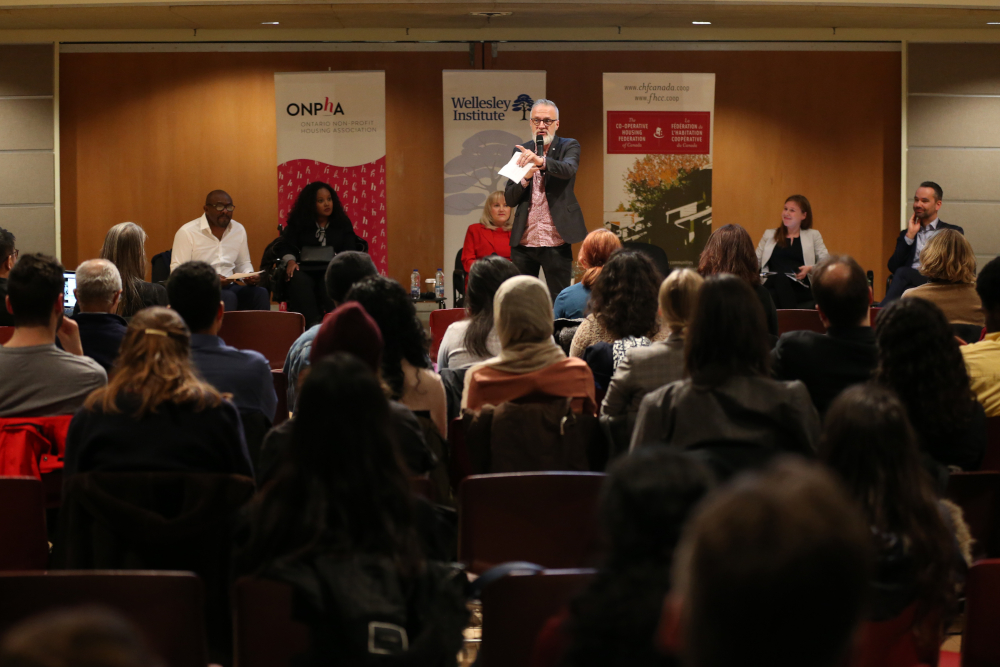Five advocates and five big ideas to fix Toronto’s housing crisis. What better way to mark National Housing Week?
This week about 200 people gathered at a downtown YMCA to discuss solutions to the city’s housing crisis.
Moderated by Wellesley Institute CEO Kwame McKenzie, the format gave each panellist five minutes to present one recommendation on how to address the housing crisis in Toronto.
Here are some highlights.
1) Make housing benefits portable and personal
Pedro Barata, senior vice-president of community impact and strategy at United Way Greater Toronto, argued it’s time to start subsidizing low-income renters.
The benefits would be portable and attached to the person, not an apartment or housing unit, a strategy that’s won support from many advocates.
Governments would provide funds directly to individuals to fill the gap between low incomes and high rents.
“The design many groups have been working on… has really asked very basic questions,” said Barata. “What is your income — your household income — what is the rent that you’re paying, and is it within range of the average market rent? And what is that gap, between your household income and your rent?”
Governments would then have to decide how much of the gap they’re willing to cover. A working group report submitted to the provincial government last year suggested gap coverage at 25 per cent in 2019-2020, moving up to 75 per cent by 2027-2028.
Through the National Housing Strategy, the federal government has pledged to put up $40 billion over 10 years that could help fund the initiative, Barata said, but implementing the plan would require a high degree of co-ordination between all three levels of government.
2) Build more affordable housing
Canada once built 20,000 units of affordable housing per year, said Simone Swail, government relations manager at the Co-operative Housing Federation of Canada.
Yet today, it struggles to build just a fraction of that.
“How did we get here?” Swail asked the audience.
Building more affordable housing doesn’t just benefit the tenants of the new units, said Swail. The increased supply can reduce upward rent pressure for all residents.
“When you increase the affordable housing supply, it’s just like when you increase the private, purpose-built rental market supply, you’re helping to increase [supply] and reduce demand in the overall market,” said Swail.
Advocates need to emphasize all the benefits of non-profit and co-op housing, as well as the broader market benefits of increasing supply, to make a strong case for the need to build more units.
“We need to start taking some of the language that the private sector uses and help bolster a case for why we need these kinds of investments,” said Swail.
3) Involve youth in the affordable housing discussion
Stephen Gaetz, director of the Canadian Observatory on Homelessness, argued the needs and voices of young people should be integrated into the discussion on affordable housing.
He suggested youth-specific housing associations as one way to achieve this, pointing to Finland, where young adults under 30 have access to below-market rent through subsidies and other supports.
He also suggested an idea from the Welsh government’s 2014 homelessness prevention plan, which instituted a “duty to assist” if someone is at risk of homelessness.
In Canada, he said, governments could create a legislated obligation for communities to provide support to young people who are at risk of homelessness or already homeless.
This would require a co-ordinated system, and an early intervention model that prioritized giving young people more options and keeping them in their communities, Gaetz said.
4) Get the government out of our way
Lori-Anne Gagne, executive director of Victoria Park Community Homes agreed with other panelists that governments need to collaborate to develop their promised strategies.
But they should leave the work of providing the housing to organizations that have the experience and track record to do the work.
“What I can say is, get the hell out of our way. How’s that for an idea?” said Gagne with a smile. “At Victoria Park, the organization I’m executive director of, we celebrate our 45th birthday next year… We have some experience. We know what works well. We know what doesn’t work well.”
Gagne was enthusiastic about the ending of operating agreements for 1,100 of the 2,300 units in the Victoria Park portfolio. The long-term agreements with government set out subsidies and allowable rents. Once an agreement ended, Victoria Park was responsible for the projects.
That was a good thing, said Gagne.
“That means no agreement with the government, no mortgage payment, some flexibility, and we are [sitting] on an asset that is worth millions.”
An appraisal showed those 1,100 units are worth more than $65 million, which Gagne said can be used to develop new affordable housing projects and repair existing ones.
5) Include disability rights in the housing conversation
Sarah Jama, co-founder of the Disability Justice Network of Ontario, said we need to talk about the fundamental rights Canadians, including Canadians with disabilities, have to housing and the ways the current system has been failing to provide the support they need.
“There are people living on Ontario Disability Support Programs and Ontario Works, but cannot pay their rent,” said Jama. “There are people who are making the choice of should I rent in this area, in a space that is not accessible, or should I move and try to find another place that’s affordable [but] doesn’t fit my needs.”
All housing discussions should include a consideration of disability rights, said Jama. “How are we going to create environments where people with disabilities fundamentally have a right to exist in their space?”
Jama said this approach is tied to ending our tendency to think of housing as a commodity.
“Stop treating [housing] like gold, stop treating it like money, and treat it for what it is: an important right,” she said. ![]()
Read more: Housing

















Tyee Commenting Guidelines
Comments that violate guidelines risk being deleted, and violations may result in a temporary or permanent user ban. Maintain the spirit of good conversation to stay in the discussion.
*Please note The Tyee is not a forum for spreading misinformation about COVID-19, denying its existence or minimizing its risk to public health.
Do:
Do not: